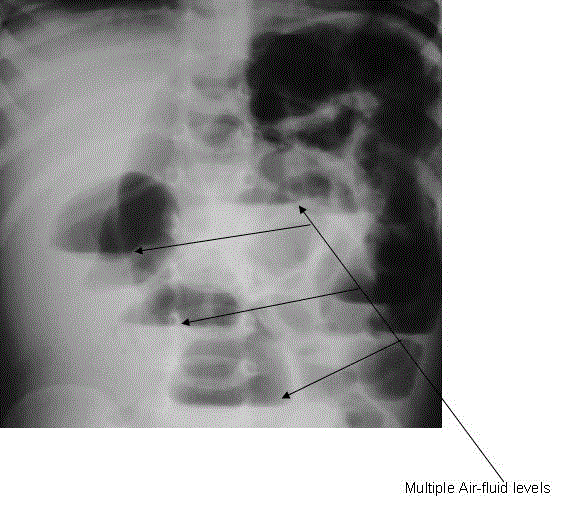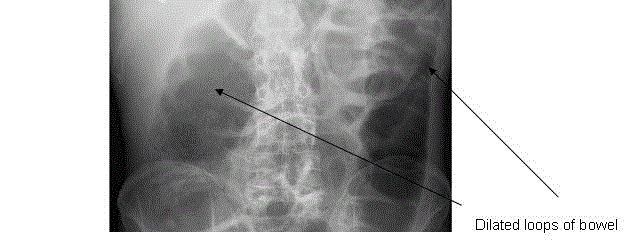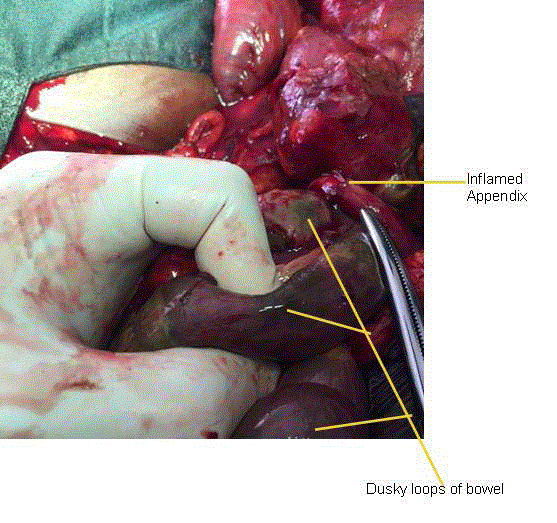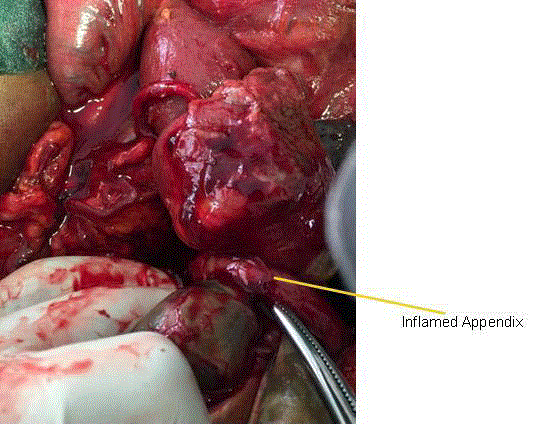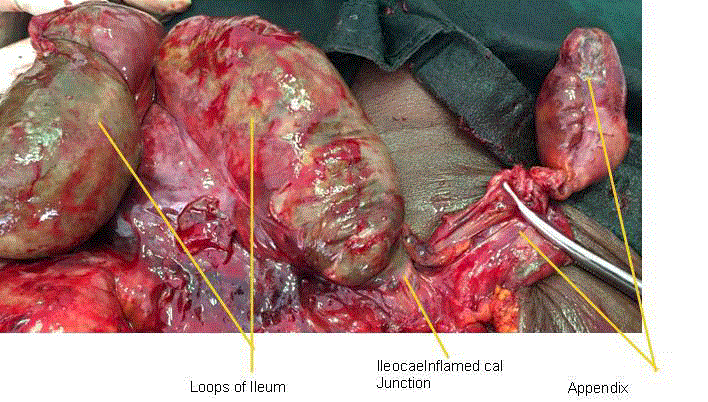Case Report
Strangulated Intestinal Obstruction due to Appendiceal Tourniquet: A Case Report
Makama JG1*, Kache SA1 and Baduku TS2
1Department of Surgery, Barau Dikko Teaching Hospital-KASU, Kaduna, Nigeria
2Department of Radiology, Barau Dikko Teaching Hospital-KASU, Kaduna, Nigeria
*Corresponding author: Makama JG, Department of Surgery, Barau Dikko Teaching Hospital-KASU, Kaduna, Nigeria
Published: 26 Apr, 2017
Cite this article as: Makama JG, Kache SA, Baduku TS.
Strangulated Intestinal Obstruction
due to Appendiceal Tourniquet: A Case
Report. Clin Surg. 2017; 2: 1436.
Abstract
Background: Intestinal obstruction is regarded as one of the most common surgical emergencies
with well known varied causes. Recently, acute appendicitis is being realised to be a significant cause.
However, strangulation of the intestine caused by appendicitis is a rare occurrence. We, therefore,
report a case of strangulated intestinal obstruction due to appendiceal tourniquet.
Materials and Methods: A case report and discussion of the relevant literature is presented.
Case Report: H R is a 28-year old young man who presented with a 5 day history of sudden onset of
abdominal pain which became generalised and worsened a day prior to presentation, was associated
with abdominal distension, vomiting of bilious gastric effluent and constipation. There was no
history of previous abdominal surgery. Physical examination revealed an ill-looking young man
who was febrile and moderately dehydrated. The abdomen was distended and tender, with guarding
and rigidity particularly in the region of the right iliac fossa. He had normal rectal findings. The rest
of the physical examination was unremarkable. Laboratory investigations were within normal limits
except leucocytosis due to Neutrophilia. Plain abdominal X-ray, erect and supine showed multiple
air-fluid levels and dilated loops of bowel indicating small bowel obstruction. The patient was
resuscitated and counseled for emergency exploratory laparotomy. Findings revealed a distended,
near gangrenous loop of ileum occluded by a ring of an inflamed appendix which was fixed at the
base and near the tip by adhesions. Appendicectomy was done to release the obstruction. Viability
of the near gangrenous ileum was restored following a 5 minute application of gauze soaked in
warm saline. The abdomen was closed in layers and patient had an uneventful recovery. Histology
report of the appendix revealed features of appendicitis. He was doing well as at last visit to surgical
outpatient department [SOPD], 6 month after operation.
Conclusion: Acute appendicitis is an important cause of intestinal obstruction. Therefore a high
index of suspicion is key to early recognition and treatment as simple appendicectomy may just
Introduction
Intestinal obstruction is often regarded as one of the most common surgical emergencies that are well known worldwide [1]. Even though, a wide range of causes of intestinal obstruction is known, there are extremely rare cases of strangulated intestinal obstruction due to an inflamed appendix [Appendicitis] that have been reported [2-4]. Previous, few reported cases of intestinal obstruction due to appendicitis have tried to describe various mechanisms of the small bowel obstruction [3- 7]. These mechanisms include small bowel ilues from pro-inflammatory mediators, mechanical obstruction due to a band forming appendicitis over loops of terminal ileum, and rarely, small bowel herniation through a tunnel formed by a base and tip adhesions to the posterior abdominal wall of a very long appendix. Rarely, does the appendix forms and occlude the small bowel in a form of a tourniquet [“tourniquet like”] [8]. We, therefore, report a case of strangulated intestinal obstruction due to appendiceal tourniquet with an explanation of the possible mechanism.
Case Presentation
H R is a 28-year old young man who presented with a 5 day history of sudden onset of abdominal
pain which became generalized and worsen a day prior to presentation associated with abdominal
distension, vomiting of bilious gastric effluent and constipation. There was no history of previous
abdominal surgery. However, patient admitted haven experienced right iliac fossa, sub acute pain sometimes 3 years back. Physical examination revealed a young
man who was toxic and ill-looking with a temperature of 38.9°C,
moderately dehydrated, pulse rate of 100 per minute and normal
blood pressure. Abdomen was distended, tender with guarding and
rigidity particularly in the region of the right iliac fossa and had
normal rectal findings. The rest of the physical examination was
unremarkable. Laboratory investigations such as full blood count
and electrolytes were within normal limits except leucocytosis due
to Neutrophilia. Plain abdominal X-ray, erect (Figure 1) and supine
(Figure 2), revealed multiple air-fluid levels that were centrally
located in the erect film and dilated loops of bowel in the supine film
indicating small bowel obstruction.
The patient was resuscitated with intravenous fluids, prophylactic
intravenous antibiotics, analgesics, nasogastric tube and urethral
catheterisation. Mean while, the patient was counseled planned and
prepared for emergency exploratory laparotomy.
A midline laparotomy was performed after adequate resuscitation.
The intra-operative findings revealed a distended, near gangrenous
loop of ileum (Figure 3) occluded by a ring of an inflamed appendix
(Figure 4) with a lot of adhesions at the base of the appendix. The ring
of appendix which was attached by adhesions at the base and tip was
resected and loops of ileum released (Figure 5). Viability of the near
gangrenous ileum was restored following a 5 minute application of
gauze soaked in warm saline. The stump of the resected appendix was
refashioned appropriately and a clean and dry field ensured before the
abdomen was closed in layers with nylon 2/0 to skin. Post-operatively,
patient had an uneventful recovery and was later discharged a week
after operation. Histology report of the appendix revealed features of
appendicitis. He was doing well as at last visit to surgical outpatient
department SOPD], 6 month after operation.
Figure 1
Figure 2
Figure 3
Figure 4
Figure 5
Discussion
The first case of intestinal obstruction due to acute appendicitis
was reported by Hotchkiss [9]. Since then a few more cases have been
reported [3,4,6], elucidating better understanding of the mechanism and consequences of this dreaded condition. In this case, the probable
mechanism may be multimodal in nature. The inflamed appendix
which initially overlies loops of terminal ileum may have spread to
involve the thin layers of the mesentery to the terminal ileum with
subsequent formation of fibrous tissue which eventually pull the
tip almost round the loops to cause a tourniquet like effect, thus,
predisposing this bowel to strangulation. This evidence was supported
by the presence of adhesion bands around the base of the appendix. It
is also possible that the inflammation in the mesentery may have led
to arterial thrombosis which resulted into the eminent strangulation
that was noted during the operation of this case.
Pre-operative diagnosis of intestinal obstruction due to acute
appendicitis has been very difficult and quite challenging. Most of the
cases reported [6-11] previously have been diagnosed at operation,
similar to the case we are reporting. This is, probably, due to the
fact that the two conditions [The cause (acute appendicitis) and the
caused (intestinal obstruction] are surgical emergencies by their
individual right thus, the urgency of the resulting condition does not
always allow time for a thorough and complete evaluation. Usually,
the course of action in emergencies such as intestinal obstruction
and appendicitis is to operate and more often than not a precise
preoperative diagnosis is believed not to be mandatory. The rarity
and accompanied paucity of knowledge of this condition has also
lent support to the challenges of making diagnosis pre-operatively.
In our case, the patient could only be diagnosed, preoperatively as a
case of intestinal obstruction and this was supported by the features
found on plain X-ray of the abdomen. Clinically, a critical evaluation
may reveal subtle features of the cause [Acute appendicitis while
the features of the caused [Intestinal obstruction] predominates [6].
In another case, the reverse may be obvious and obtainable. The
most difficult to diagnose may be that entity when features of both
conditions are dominant. Although, Awale et al. [7] has reported
that abdominal CT scan may be a useful diagnostic imaging modality
in early cases where features of inflammation of the appendix may
be so obvious. In our environment, including most other places
in the low and middle income countries, it may still be difficult to
diagnose due to the fact that a facility such as abdominal CT scan is
still expensive and have limited access. Furthermore, these patients
often present late, a stage, where the inflammatory period may have
gone past before they present themselves. Hence, we may still rely
on a thorough history and physical examination coupled with a very
high index of suspicion [12].
The intra-operative treatment of the intestinal obstruction,
which is often achieved by immediate appendectomy, is very straight
forward once there is no associated strangulation of the loops of bowel
[2,6,13]. Even in the early part of strangulation when the viability of
the loops of bowel could still be restored as it was done in the case
we are reporting, the treatment by performing appendicectomy may
suffice. However, when gangrene set in, segmental resection and
anastomosis of the bowel, in addition to the appendicectomy may
be done. On the other hand, if the gangrenous bowel is extensive
and close to the ileo-caecal junction, the appropriate treatment will
be to do a limited right hemicolectomy. Of course, these additional
procedures may increase hospital stay, mortality and even the risk of
residual morbidity if the patient eventually survives.
A very useful approach that has shown to be vital in the treatment
of these cases is open laparotomy. Most previous [2-4,7] cases
including the case we are reporting were treated by open surgery and
through a midline skin incision. This has facilitated easy identification
of both conditions and their subsequent optimal treatment. Even in
situations where features of appendicitis predominated, and the initial
approach was erroneously made through the regular Mcbourney’s
point, it was thought wise to have abandoned it for midline incision.
To the best of our knowledge and review of the literature, no case
of intestinal obstruction due to acute appendicitis has been managed
laparoscopically. However, going by the rapid advancement in
laparoscopic surgery it is believed that laparoscopy holds a lot of
promises to both diagnostic as well as therapeutic management of
this entity.
Conclusion
Acute appendicitis is an important cause of intestinal obstruction. There are several mechanisms by which this could be achieved. Therefore a high index of clinical suspicion is key to early recognition and treatment as simple appendicectomy may just suffice.
References
- Evers MB.Small Intestine. In Sabiston text book of surgery. 18th edition. Edited by: Townsend CM. Philadelphia: SAUNDERS; 2008;2:1296.
- Yu-Guang Chen, Hao-Ming Chang, Yen-Lin Chen, Yi-Chiao Cheng, Chin-Hui Hsu. Perforated acute appendicitis resulting from appendiceal villous adenoma presenting with small bowel obstruction: a case report. BMC Gastroenterology 2011;11:35-38.
- Assenza M, Ricci G, Bartolucci P, Modini C. Mechanical small bowel obstruction due to an inflamed appendix wrapping around the last loop of ileum. G Chir. 2005;26:261-66.
- Harrison S, Mahawar K, Brown D, Boobis L, Small P. Acute appendicitis presenting as small bowel obstruction: two case reports. Cases J. 2009;2:9106.
- Naumon ID. Two cases of strangulation of the small intestine in the loop of the appendix. Khirurgiia Mosk1963;39:130-2.
- Srivatsan M. Intestinal obstruction caused by a long appendix ensnaring a loop of ileum. J med Ind Ass1964;43:400-401.
- Laxminarayan Bhandari, PG Mohandas. Appendicitis as a cause of intestinal strangulation: a case report and review. World J Emerg Surg. 2009;4:34-38.
- Awale L, Joshi BR, Rajbanshi S, Adhikary S. Appendiceal tie syndrome: A very rare complication of a common disease. World J Gastrointest Surg2015;7(4): 67-70
- O'Donnell ME, Sharif MA, O'Kane A, Spence RA. Small bowel obstruction secondary to an appendiceal tourniquet. Ir J Med Sci. 2009;1789(1):101-105.
- Hotchkiss Lucius W. Acute intestinal obstruction following appendicitis. A report of three cases successfully operated upon. Ann Surg.1901;34:660-77.
- Forbes Hawkes. The prevention of intestinal obstruction following operation for appendicitis. Ann Surg. 1909;49(2):192-207.
- Croome RRM, Knox J. Large bowel obstruction with acute appendicitis. Can Med Assoc J 1954;70(6):681.
- Bose SM, Talwar BL. Appendicitis causing acute intestinal obstruction with strangulation. Aust NZ J Surg. 1973;43:56-7.

